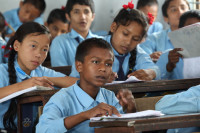Opinion
Colour of health
The new standard of 90 ppm lead in paints will ultimately help eliminate leaded paint from Nepal
Ram Charitra Sah
Three consecutive studies of lead in paint carried out for the first time in Nepal by a research-based non-governmental organisation, the Center for Public Health and Environmental Development (Cephed), from 2010 to 2013, found that over 70 percent of paints, especially enamel paints, contain high levels of lead—well above than 90 parts per million (ppm), the internationally accepted standard for lead in paints. The maximum level of lead in the 2013 study was 130,000 ppm, 1,444 times more than the American, Chinese, and Indian standard for lead in paints. All this in the absence of required legislative and institutional frameworks to regulate the amount of lead in paints.
Hazardous levels
A study conducted by New York University in 2013 revealed high economic losses to Nepal due to lead exposure, equalling $1.5 million or four percent of Nepal’s GDP, an amount that is very likely much higher than the total revenue from lead-related businesses as a whole to Nepal.
Dust samples collected from five out of five (100 percent) of school classrooms in the Kathmandu Valley were found to be contaminated with lead. Seventy-seven percent of the classroom floor dust samples contained hazardous levels of lead more than 10 µg/ft2 and even 23 percent contained dangerous levels of lead more than 40 µg/ft2. The maximum lead level in school was found to be 108 µg/ft2 by the 2014 Cephed study.
Another study by Dr Mehta, KD et al in 2014, which evaluated blood lead levels among 304 primary school-going children in Kathmandu Metropolitan City revealed that 73 percent of the children had detectable blood lead levels, 66 percent had blood lead levels higher than 5µg/dl (the Center for Disease Control and Prevention’s recommended value). And in 55 percent of children, blood lead levels were higher than 10 µg/dl (the World Health Organisation recommended value). Blood lead levels were significantly higher in children living in homes with chipped wall paint.
Government response
Responding to our years-long campaign based on these pioneering scientific studies in Nepal with very serious and alarming findings, a new mandatory standard of 90 ppm lead in paints has been promulgated by the Government of Nepal’s Ministry of Science, Technology and Environment by publishing a notice in the Nepal Gazette (Khand 64, Number 30, Part 5, Notice No. 3 December 22, 2014) as per the Rule 15 of the Environment Protection Regulation 1997. The standard will come into effect after 181 days, on June 20.
The new standard sets a mandatory limit of 90 ppm lead content for any paint imported, produced, sold, or used in Nepal. The standard is consistent with other lead paint standards around the world. The newly formulated standard will only allow this maximum lead content in all kinds of paints and will also require precautionary information to prevent occupational exposure to paint, and aims to ensure the public well-being, particularly the health of children while also ensuring protection of the environment.
Excellent move
Nepal is the 53rd country in the world to establish lead paint regulation and one of only a handful of low- and middle-income countries to set limits on lead in paint. The Global Alliance to Eliminate Lead Paint, a joint initiative of the United Nations Environment Programme and WHO, has set a goal of eliminating lead in paint in all countries by the year 2020. So the recent move by the Nepali government will help ensure elimination of leaded paint from Nepal.
So on behalf of the children of Nepal, we congratulate the Government of Nepal, the Office of the Prime Minister and Council of Ministers, and the Environment Ministry for this visionary action of enacting this much-awaited mandatory standard for lead in paint. Nepali children will now be protected from lead exposure in their homes and in schools where heavily leaded paints are commonly used. The effective implementation of the new standard will ensure that the children of Nepal grow up to be healthy adults who can reach their full intellectual potential. We are happy to have our own national standard for lead in paints and call for its effective implementation by all concerned.
Sah is executive director of the Centre for Public Health and Environmental Development (Cephed)




 10.12°C Kathmandu
10.12°C Kathmandu










